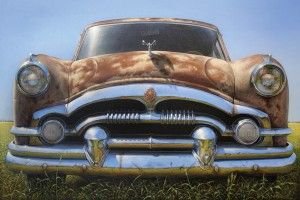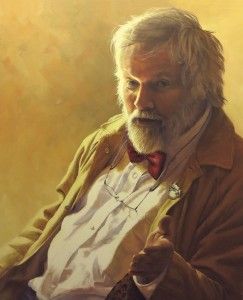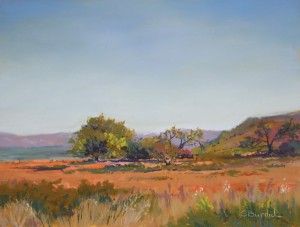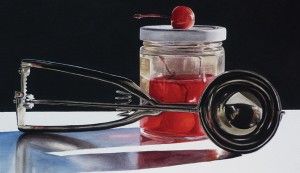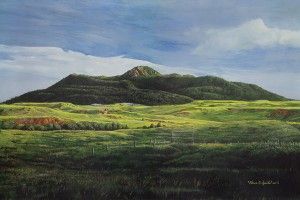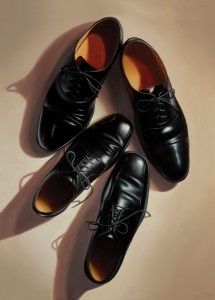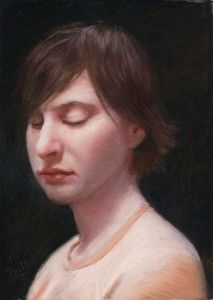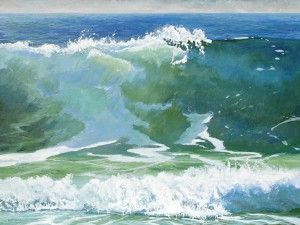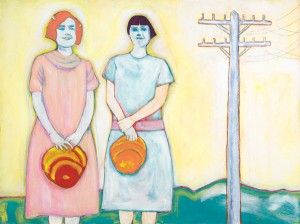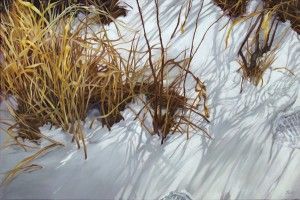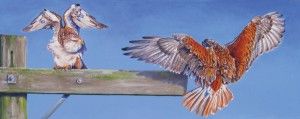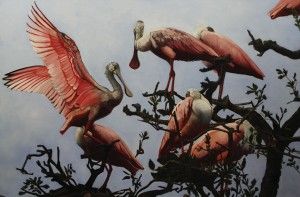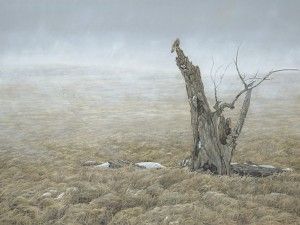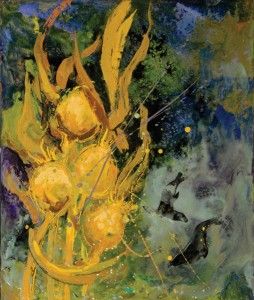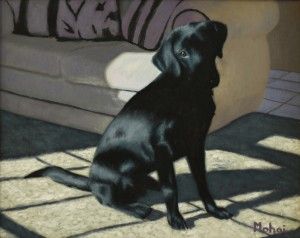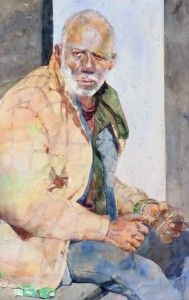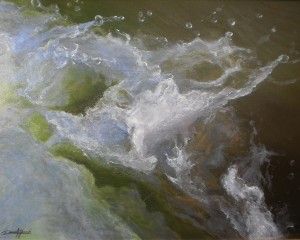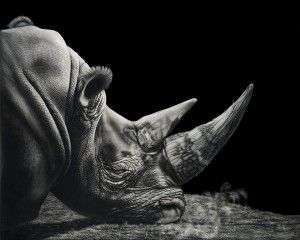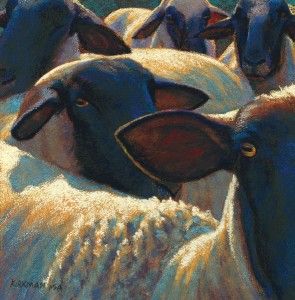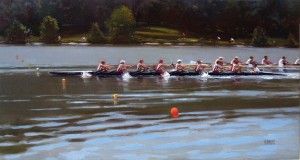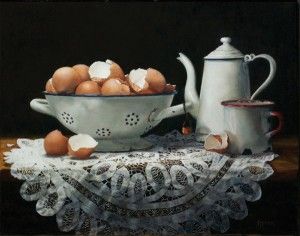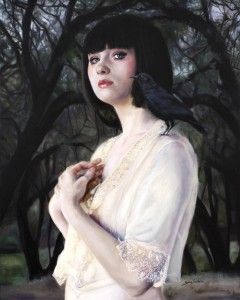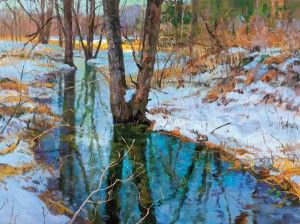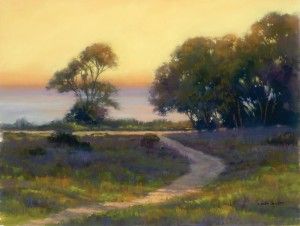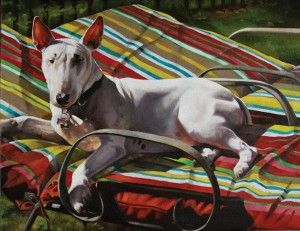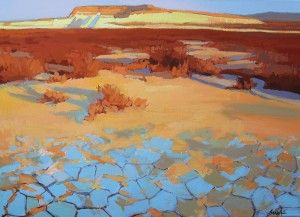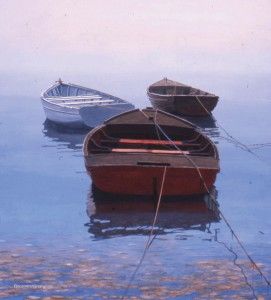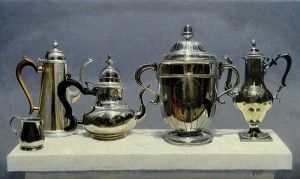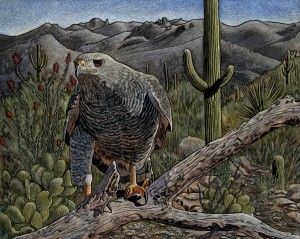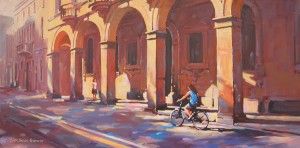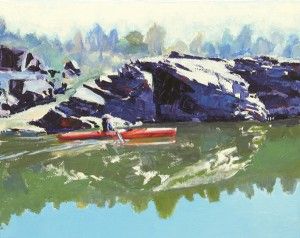For 30 years, The Artist’s Magazine, which is Southwest Art’s sister publication, has conducted an annual art competition that is open to artists all over the world. From the more than 6,000 entries received this year, 30 winners and approximately 300 finalists in five categories were chosen by respected jurors Douglas Atwill, John N. Agnew, Ron Monsma, Amy Weiskopf, and Judith T. Greenberg. In the following pages we present a sampling of the impressive works from these winning artists.
Where did you study art? I have a bachelor of fine arts degree from Murray State University in Murray, KY. I then studied on my own for several years. A Robert Bateman workshop helped. In the mid-1980s I worked with Frank Howell in his Denver studio and later in his Santa Fe studio.
How would you describe your style? I refer to my style as interpretative realism. I observe the reality of the world and then blend it with my own life and spiritual experiences to create an alternative realism that allows the viewer to relate on many levels.
What’s the most meaningful recognition you’ve received for your artwork? I am in the permanent collection of the Colorado Springs Fine Arts Center and the Sangre de Cristo Arts and Conference Center in Pueblo, CO, where I have also had a solo exhibition. And I was juried into Art Renewal Center’s annual Salon in both 2012 and 2013.
What are your goals for the future? To stay healthy. Draw more. Push my work to the edge. Take chances—it’s only paint and canvas. And have fun.
What galleries represent your work? The Longworth Gallery, Santa Fe, NM; Lilly Vigil Gallery, Nevada City, CA; Gallery 150, Salida, CO; Michael’s on Main, Cañon City, CO.
Where did you study art? My art did not start with any formal training, but I was fortunate that my first two tutors were both very good and different in their methods. This allowed me to keep my mind open to different styles and methods of working. Watching demonstrations and going to workshops in the earlier years also gave me insight as to how different artists approach their work.
How would you describe your style? Representational.
What’s the most meaningful recognition you’ve received for your artwork? I’ve received many awards over the years, but the most significant award to date is winning the Mortimore Art Prize in 2011. This is an international art prize worth $15,000. It was the first time I had entered, and it was especially gratifying.
What are your goals for the future? I have been quite a prolific painter, but I feel that now is the time for me to take stock and look at more of what I’d like to paint. Maybe that old saying of “less is best” is where I am right now. I would now like to spend more time on each piece, aiming to paint more memorable work and keep producing better paintings.
What galleries represent your work? Di King Gallery, Healesville; Seaview Gallery, Queenscliff; The Brialyn Boathouse Gallery, Frankston, all in Victoria, Australia.
Where did you study art? I have a bachelor’s degree in fine arts from Utah State University, and I have taken art classes and workshops with pastel artists such as Richard McKinley, Clark Mitchell, and Kim Lordier. I love pastel because it is very tactile, and I can get colors and depth you can’t get in watercolor.
How would you describe your style? Richard McKinley, when he mentored me, said that I had a unique style. I use strength of color. I look to achieve as much depth as I can. And there is an abstract nature to my work that is unique—a different approach and feel. My style is influenced by the Sierra foothills because I live at the gateway to Yosemite National Park.
What’s the most meaningful recognition you’ve
received for your artwork? I have won best-of-show and first-place awards, but for me, the best recognition involves the people who come into my gallery, stand in front of a piece, and interpret it. To me, recognition is what you get one-on-one with people.
What are your goals for the future? I want to build my gallery, build my art, and teach.
What galleries represent your work? A Sense of Place, Fresno, CA; Williams Gallery West, Oakhurst, CA.
Where did you study art? I studied graphic design at Prairie State College in Illinois. Illustration was the only part I really had interest in because it was just plain fun.
How would you describe your style? My style is very realistic, with dramatic lighting. I try to make a bold, simple statement with my work.
What’s the most meaningful recognition you’ve received for your artwork? Being included in the Splash 14 watercolor book from North Light Books is my biggest achievement so far. Having my work alongside so many amazing artists from all over is about as good as it gets.
What are your goals for the future? I love creating, and I plan to keep producing artwork as long as there is a market for it. It is a symbiotic relationship between my pleasure of painting and giving others pleasure when they view my work.
What galleries represent your work? Weems Galleries and Framing, Albuquerque, NM; Boudreau Jewelers and Gallery, Las Cruces, NM; Adobe Patio Gallery, Mesilla, NM.
Where did you study art? I have learned from many different places. First from my father, a very talented antler and wood artist, and then at Combat Illustrator School in Ft. Meade, MD, where I gained experience as a combat illustrator for the Marine Corps. I have an art degree from Black Hills State University. I have also learned a great deal from studying great artists’ works and their books.
How would you describe your style? Realistic.
What’s the most meaningful recognition you’ve received for your artwork? When someone purchases my artwork with his or her hard-earned money, I feel very recognized and blessed. In addition to that, being chosen to have my artwork on the National Wild Turkey Federation stamp for 2012.
What are your goals for the future? Build my own studio and gallery. Win the federal duck-stamp competition. Continue to increase the quality of my artwork. Bless many people in the process.
What galleries represent your work? 1875 Gallery, Sundance, WY.
Where did you study art? My most important teacher and mentor is my father, Philip Barlow. I grew up watching him paint, living with his paintings, and visiting galleries with him. Once I committed myself to being an artist, I realized that his exquisite eye has profoundly influenced my own. I studied at the University of California, Berkeley and, for a blissful, too-short time, at the Art Students League of New York.
How would you describe your style? I am a contemporary realist working in the still-life genre, but because I have always been inspired by the portraiture genre, I call my paintings “portraits in absentia.” I create paintings of people using their belongings, rather than their faces, to explore their lives. I believe that the deep emotional content inherent in personal objects presents rich opportunities for storytelling. My paintings can be seen as allegories of contemporary life.
What’s the most meaningful recognition you’ve received for your artwork? Best of all is when someone sees my work and wants to bring it home to live with it. That is why I paint: to share how I see things and to have my vision move someone.
What are your goals for the future? I want to deepen with every painting and to share my work with an ever-widening audience.
What galleries represent your work? Gallerie Citi, Burlingame, CA; District Gallery, Park City, UT; Elliott Fouts Gallery, Sacramento, CA.
Where did you study art? I studied privately with local Chicago artists. I also took workshops with David Leffel and William Schneider at the Palette & Chisel Academy in Chicago and studied privately with Ramon Kelley. In 2007 I attended the Florence Academy of Art’s summer session, where I met Matt Almy, who also lived in Chicago. Almy and his wife, Magda, later started the Ravenswood Atelier, where I completed my training in 2011.
How would you describe your style? I am not sure I have found my style yet. I just consider myself a representational painter. I paint what I find interesting or beautiful.
What’s the most meaningful recognition you’ve
received for your artwork? In 2015 I will be inducted into the International Association of Pastel Societies’ Master Circle. I am also a signature member of the Pastel Society of New Mexico and the Pastel Society of America. To be honest, though, the most meaningful recognition is when one of my four children thinks one of my paintings is “cool.”
What are your goals for the future? I just moved to Santa Fe from Chicago, so my most immediate goal is to find a few galleries to represent my work. After that, to become the best painter I can possibly be.
Where did you study art? I am self-taught through art classes in school, art history in college, dozens of books, and spending scores of hours in art museums around the world. I started in oils when I was a teenager, switched to acrylics, and just recently revisited oils.
How would you describe your style? My style ranges between impressionism and realism.
What’s the most meaningful recognition you’ve received for your artwork? A recent article about my work in Elan magazine and having my work selected for publication in North Light Books’ new book on acrylic painting. But most meaningful for me is when someone really connects to one of my paintings or a collector returns to acquire more of my work.
What are your goals for the future? To participate in more exhibitions, art festivals, and galleries. Finding the right gallery to represent my work would be nice or even opening my own.
What galleries represent your work? Xanadu Gallery, Scottsdale, AZ.
Where did you study art? I grew up watching my mother, Karen McCurtain-Blair, paint. I guess I learned by osmosis. When I was in fourth and fifth grade, I started to learn art history thanks to my mother and a friend who started an art program at my school, Lincoln School in Buenos Aires, Argentina. I also took one college-level painting class in Santa Fe after getting my bachelor’s degree in English from the University of New Mexico in Albuquerque.
How would you describe your style? I paint big, bright, figurative acrylics. The figures are stylized and flat. The backgrounds are abstracted. I don’t sign my work. I believe that it is recognizable without a signature.
What’s the most meaningful recognition you’ve received for your artwork? Generally, every time that someone really connects with my work.
What are your goals for the future? Right now, I am sleeping on a couch in my art studio. I have sacrificed everything for my art, including my sanity. My back is starting to suffer. It’s time for a real bed. Irony aside, I would like to expand beyond the Southwest region of the United States and find representation on the East and West Coasts.
What galleries represent your work? Taos Artisans’ Gallery, Taos, NM.
Where did you study art? I’ve studied at the university as well as at the local level, but my association with the Art Students League of Denver has, by far, given me the most confidence and skill necessary to create my style of paintings. In particular, instructors Jane Jones and Robert Gratiot have been the most influential to my approach.
How would you describe your style?
Representational. I find beauty in the overlooked part of nature. Whether it’s a forgotten clump of grass on a snowy hillside or autumn reflections in a rocky pool, I hope to create an intimate view of the less showy side of our environment. Each painting is based on a series of photographs that I capture during a hike or bike ride. Using oil paints, I apply several thin coats of pigment to develop a richer and more tangible feel.
What’s the most meaningful recognition you’ve received for your artwork? I have been honored with several awards, but knowing that something I’ve created hangs in a stranger’s home and brings them joy is significant.
What are your goals for the future? To continue painting and exploring the Rocky Mountain West for its treasures.
What galleries represent your work? Elements 5280 Gallery, Greenwood Village, CO.
Where did you study art? I attended Berry College, Mount Berry, GA; Wesleyan College, Macon, GA; and Gordon State College, Barnesville, GA.
How would you describe your style? I use a rich color palette in a style that is representational but not photo-realistic. I leave enough mystery for the viewer to engage themselves, much like a conversation, only in paint. Composition is key.
What’s the most meaningful recognition you’ve received for your artwork? Personally, the most meaningful recognition was the reaction from my 90-year-old father when I presented him with a life-size terra-cotta bust of my mother, who died at age 59. He studied the piece and quietly said, “She seems to be beckoning to me.”
What are your goals for the future? I have two upcoming shows: a three-person show in April at Quinlan Visual Arts Center in Gainesville, GA, and a solo show this fall at Art on the Avenue in Macon, GA. I will continue to paint with stimulating peers and pursue more sculpting with Marlin Adams, a teacher whom I consider to be a classical master.
What galleries represent your work? Art on the Avenue, Macon, GA; Arts Clayton, Jonesboro, GA; Downtown Gallery at the Booth Western Art Museum, Cartersville, GA.
Where did you study art? I have sought out workshops with artists whose work I admire, including Richard McKinley, John Seerey-Lester, Julie T. Chapman, Desmond O’Hagan, and Kim Lordier. Participating in the last two International Association of Pastel Societies conferences has probably had more impact than anything else I have done.
How would you describe your style? Representational, bold in color, strong in values, and frequently incorporating large negative space areas. I try to push the colors to enhance the drama or atmosphere of any given piece, while still retaining strong realism.
What’s the most meaningful recognition you’ve received for your artwork? To date, having placed in Southwest Art’s 2012 Artistic Excellence competition has been the highlight of my art career.
What are your goals for the future? I want to build a reputation as a sought-after wildlife artist. Additionally, I’ve recently initiated a series of paintings based on the rodeo. I am working with a friend here in Huntsville who is helping me find Texas venues for rodeo-based art and to cultivate a rodeo/western art following for my work.
What galleries represent your work? I am currently seeking gallery representation. However, my work is frequently on exhibition in the gallery at Sam Houston State University, and I have pieces hanging in the two Huntsville locations of the Community Service Credit Union, of which I am the CFO.
Where did you study art? I originally learned how to paint from my high school art teacher, Brenda Savella, and from Robert Bateman. I have also completed two foundation studio courses and one introductory-level art history/museum studies course while working toward my environmental science degree at the University of Lethbridge in Alberta, Canada.
How would you describe your style? My style is a unique Canadian approach with roots in American realism.
What’s the most meaningful recognition you’ve received for your artwork? Winning the national youth Robert Bateman Get to Know Your Wild Neighbours art contest at the age of 17.
What are your goals for the future? I want to continue to paint the land that I am truly passionate about. And at the same time contribute to the conservation of this fragile land through my artwork by donating proceeds from the sales of my grassland series toward conservation efforts.
What galleries represent your work? The Royal Alberta Museum, Edmonton, Canada.
Where did you study art? I have an undergraduate degree in art history from the University of Pittsburgh and a post-graduate degree in art as applied to medicine from the Faculty of Medicine at the University of Toronto. My fine-art career segued from medical illustration to several years’ work in etching, engraving, and lithography, then to exploration of neon sculpture, and finally to pastel and encaustic.
How would you describe your style? Expressionistic.
What’s the most meaningful recognition you’ve received for your artwork? Being invited to teach a full-size workshop at the New Braunfels Art League in Texas. Up to that time I had been teaching occasional one-day workshops locally and private lessons in my studio.
What are your goals for the future? I want to continue mentoring several artists in my area and perhaps do more workshops. I would like to expand the number of galleries carrying my work. Above all, I want to continue experimentation and growth in my work.
What galleries represent your work? Childhood’s End Gallery, Olympia, WA.
Where did you study art? I received formal education in the visual arts since the age of 6. Being exposed mostly to the classical masters’ work provided a foundation for my artistic development. Years later I moved to Spring Hill, FL, which is next to Aripeka, where the world renowned pop-art master James Rosenquist has his studio. I joined Mary Petricone’s art studio in order to develop new skills in drawing, pastel, watercolor, and acrylics. Mary introduced me to Antonio (Tony) Caparello, who was Rosenquist’s painter and studio assistant for 10 years. Tony was one of the finest photo-realists we ever had, and I have been privileged to study oil painting with him.
How would you describe your style? Realism and photo-realism with occasional surrealist infusion.
What’s the most meaningful recognition you’ve received for your artwork? Being chosen as a finalist in The Artist’s Magazine’s 30th annual art competition. I feel very honored by the jury’s selection considering there were over 6,000 entries this year.
What are your goals for the future? I would like to incorporate more surrealist and thought-provoking themes in my painting and to continue Caparello’s legacy in promoting the fine arts.
Where did you study art? My background is in the fields of education, psychology, and counseling. I became interested in learning to paint while working with children and witnessing the magic of art in helping them safely express strong feelings. At that point, I began taking workshops and studying from my ever-growing library of art books.
How would you describe your style? I’ve always been a student of human behavior, and my paintings are the result of my attraction to a character quality that I perceive or imagine to exist within my subject. Using a somewhat limited palette, I paint with “loose representation” of the subject, focusing upon my emotional response to that subject.
What’s the most meaningful recognition you’ve received for your artwork? Professionally, being juried into the American Watercolor Society Annual Exhibition was great recognition. Personally, I find nothing more fulfilling than when a viewer lets me know that I have captured the essence of a character.
What are your goals for the future? My goals are pretty simple. I am committed to being a lifelong student of art, continuing to hone my craft by studying, taking risks in my work, and developing my ability to communicate with paint.
What galleries represent your work? Harper Studio, Scottsdale, AZ; Kalispell Grand Hotel, Kalispell, MT.
Where did you study art? I studied art at Colby Community College in Kansas and at the Federal University of Minas Gerais in Brazil. However, classes with artist Angelo Allen in Los Angeles taught me more than any art school.
How would you describe your style? I am an animal artist with a passion for experimentation. As much as I try to make accurate pastel portraits for my clients, my creative work in acrylic is free flowing and unique. The animal theme is present in all my works.
What’s the most meaningful recognition you’ve received for your artwork? HERE, IF YOU NEED ME received four awards at the American Whippet Club National Art Show: Best Professional Artist, Best Painting, People’s Choice, and Best in Show. I was honored that the whippet community was so welcoming of my art, since it was my first time entering the show. The piece was featured as the cover for The Whippet News in 2013.
What are your goals for the future? I have only recently become a professional artist, so my goal is to continue pursuing a successful career in the field, being true to my style and artistic passion.
Where did you study art? I have a bachelor’s degree in fine art and studio art from Montclair State University in New Jersey. I am also a member of the Morris County Art Association and the American Society of Marine Artists.
How would you describe your style? I call my style contemporary intrinsic realism. It is a style that develops images based on varying views of the subject matter. I painted FREE FOAM based on a segment of the Gulf of Mexico in Marco Island, FL. I picked the segment of foam and noted the colorations and varying shapes as it folded down the face of a wave. I feel there are so many abstract designs and contemporary abstracts in nature that it would be a shame not to paint them.
What’s the most meaningful recognition you’ve received for your artwork? When people enjoy the paintings and feel what I feel, that is the recognition that is meaningful.
What are your goals for the future? I want to take what nature has to offer and develop paintings that viewers, art lovers, and people in general will appreciate.
What galleries represent your work? Lindenwold Gallery, Atrium Gallery, Gallery at 14 Maple, Linda Grandis Blatt Gallery, and Art Upstairs Gallery, all in Morristown, NJ.
Where did you study art? I learned some techniques for detailed art when I took science illustration courses at the University of California, Santa Cruz. It was here that I was first introduced to scratchboard and taught to pay attention to fur patterns, muscle structure, and biological accuracy.
How would you describe your style? I’m drawn to animals’ faces in dramatic light. With meticulous attention to detail, I like to show just how much beauty they possess.
What’s the most meaningful recognition you’ve received for your artwork? I love the reaction of people who view my work and are in awe that it’s drawn and not a photo. It never ceases to make me laugh when I say, “Um, it’s not a photo, I drew it.”
What are your goals for the future? I want to continue to bring the medium of scratchboard to the public eye. It’s an old medium, yet so few know about it, or they associate it with the clunky student boards they used in school. I’ve only begun to show what you can do with it.
What galleries represent your work? Celebration Fine Art, San Diego, CA; Metalography Gallery, Temecula, CA.
Where did you study art? I have an associate of art degree from Lourdes College in Sylvania, OH, and a bachelor of art from the University of Dayton.
How would you describe your style? Contemporary realism, but my focus is mainly composition and light. I admire the impressionists and try to capture light as they did, but in some of my portraiture work I can become very tight and realistic.
What’s the most meaningful recognition you’ve received for your artwork? I have a lot of awards that I like to brag about and that sound good on my bio, but it was all of the recognition and praise I received as a child whenever I would draw something that meant the most. I was never left with any doubt that I would be an artist when I grew up.
What are your goals for the future? I like to imagine myself in the future with a dozen magazine features and covers, work in five major global galleries, and enough income to support giving and taking workshops in exotic locations around the world.
What galleries represent your work? River’s Edge Gallery, Kerrville, TX; The Gallery at Round Top, Round Top, TX; Cactus Jack’s, Gruene, TX; The Gallery at Brookwood Community, Brookshire, TX.
Where did you study art? When I was young, my family moved from Africa to Canada, where I attended a high school in Toronto. I studied commercial art and painting and then went on to Sheridan College for arts and technology. Generally speaking, though, I am self-taught.
How would you describe your style? I paint what I experience, whether it’s wildlife or landscapes. While observing nature, light, shadows, and movement, I am drawn to re-create that feeling in the studio. I believe my work would be described as representational.
What’s the most meaningful recognition you’ve received for your artwork? In 2012 I was chosen as the BC Wildlife Federation Artist of the Year. Being able to paint every day and selling my work is a dream come true.
What are your goals for the future? To continue to grow as an artist, discovering better techniques, taking on bigger challenges, and reaching a broader audience through expanding gallery representation.
What galleries represent your work? The Barn Gallery, Oyama, BC, Canada; Nadine’s Fine Art, Vernon, BC, Canada; Picture Perfect, Kelowna, BC, Canada.
Where did you study art? I studied at the American Academy of Art for a short time. Later, I took life-drawing and painting classes at the Art Institute of Chicago and attended workshops with Burt Silverman, Albert Handell, and Ken Auster.
How would you describe your style? I think my work might be described as impressionistic realism. I’m continually working toward creating a more poetic mood through color harmony and expressive brushwork.
What’s the most meaningful recognition you’ve received for your artwork? I have been very fortunate to receive signature status in the Pastel Society of America and the American Impressionist Society, and Masters Circle designation in the International Association of Pastel Societies. But the most meaningful honor has been my recent second-place award for a pastel landscape at this year’s American Impressionist Society national juried exhibition in Charleston.
What are your goals for the future? Recently I began teaching a weekly pastel class in Chicago’s Old Town Triangle Art Center and realized how much I love sharing everything I’ve learned with my students. As I continue to investigate and challenge myself in my own work, I look forward to teaching more workshops throughout the year and painting more often with my artist friends.
What galleries represent your work? Mountainsong Galleries, Carmel, CA; Elizabeth Pollie Fine Art, Harbor Springs, MI; Kathleen Newman Studio, Chicago, IL.
Where did you study art? Years ago, I took classes from master painter Gustav Likan. Most recently, I’ve attended workshops and demonstrations with contemporary masters: Mark Carder, Stephanie Birdsall, Braldt Bralds, and Sherrie McGraw.
What’s the most meaningful recognition you’ve received for your artwork? It’s hard to pinpoint the most meaningful, but I’d have to say being chosen as an Artist to Watch by Southwest Art and receiving the Merit Award in the still-life category in the 2013 Salon International competition. Receiving these two recognitions, along with earning a Juror Award at the Women Artists of the West National Exhibit in Estes Park, CO, have all been exciting recent achievements. I’m grateful and humbled by these acknowledgments because I have great respect for the artists who exhibited and the quality of the work entered for each of these exhibits.
What are your goals for the future? My future goals include continuing to develop into the best painter I can be and partnering with a few more galleries that are a good fit for my work.
What galleries represent your work? Cactus Jack’s, Gruene, TX.
Where did you study art? I studied at the Academy of Art University in San Francisco.
How would you describe your style? I describe my style as realism with a whimsical twist. In my current body of work I am playing with making things slightly more surreal, and I am having a lot of fun with that.
What’s the most meaningful recognition you’ve received for your artwork? It is very exciting for artists to see their work in print, so anytime that happens I am thrilled. I was so very happy when I was chosen as one of Southwest Art magazine’s “21 Under 31” in 2011.
What are your goals for the future? My goals are to keep building on the great relationships I have with my galleries and to keep on painting. My husband, Shane, is also a painter, and we are making fun changes in our work and studio that will take our art in new and exciting directions.
What galleries represent your work? Wally Workman Gallery, Austin, TX; JRB Art at the Elms, Oklahoma City, OK; Sandra Lee Gallery, San Francisco, CA.
Where did you study art? I studied at Pratt Institute in Brooklyn and later at the Art Students League of New York.
How would you describe your style? It’s a funny question in that I don’t consider I have a style or a school that I can claim. I paint simply and as directly as possible, so that I might achieve an honest emotional response to my subject.
What’s the most meaningful recognition you’ve received for your artwork? I’ve won awards, and I have received acclaim. But the most meaningful recognition is when people tell me how a particular painting reminds them of a part of their life that was almost forgotten, and it brings it back to them in a very real way. Being able to communicate and strike a chord with an individual is the most meaningful.
What are your goals for the future? I look forward to exploring larger canvases with new ways of seeing and making marks in painting.
What galleries represent your work? Travis Gallery, New Hope, PA; RS Hanna Gallery, Fredericksburg, TX; The Banks Gallery, New London, NH; Art Essex Gallery, Essex, CT.
Linda Mutti
Where did you study art? I studied art at the University of California, Santa Barbara. I continued by taking workshops from wonderful artists, such as Richard McKinley, Kim Lordier, Glenna Hartmann, Jean LeGassick, and Albert Handell.
How would you describe your style? I would describe my style as representational with a lean toward impressionism. I am most enthralled with the effects of the light on
the landscape.
What’s the most meaningful recognition you’ve received for your artwork? I have won some national awards, but the best and most meaningful recognition ever was when one of my paintings brought happy tears to the eyes of a viewer.
What are your goals for the future? My goals are to continue on the path of learning my craft. I would like to become braver and looser in my work, pushing the envelope a little.
What galleries represent your work? Gallery Los Olivos, Los Olivos, CA; Bronze, Silver & Gold Gallery, Cambria, CA.
Where did you study art? I went to Ringling School of Art in Sarasota, FL. After two years there, I had the chance to learn privately from portrait painter Nelson Shanks, which was one of the most valuable experiences I have ever had. I learned so much from him.
How would you describe your style? My style is more classical than modern, and I am definitely a realist. I get really excited about light and setting a mood or atmosphere. I love painting animals because I relate to them more than anything else. But I think with the right light, even a very simple subject can be beautiful.
What’s the most meaningful recognition you’ve received for your artwork? While awards and recognition are wonderful, what means the most to me is the feedback I get from my clients. They are very attached to their animals. Many people tell me that when their animals have passed, they get great comfort from their animals’ portraits. That is an incredible reward for me.
What are your goals for the future? I hope to learn more with every painting. I hope to continue to improve my art and make people happy with what I do.
Where did you study art? Even though I received a degree in art from California State University, Fresno, I attribute my real studies in art to a handful of gifted individual artists who graciously share their talents by teaching workshops and mentorships. I have been privileged to mentor under Richard McKinley and have studied under other artists such as Kim Lordier, Tina Moore, Lesley Harrison, and Lian Quan Zhen.
How would you describe your style? Representational, leaning toward impressionism.
What’s the most meaningful recognition you’ve received for your artwork? Of course, it is very validating to receive an award in an art competition. But the most meaningful recognition for me is when someone looks at a portrait and feels there is a spark of life. Or views a landscape and feels a sense of peace. I am humbled and honored when this happens. It is the best recognition of all.
What are your goals for the future? To keep learning and paint, paint, paint.
What galleries represent your work? Fresno Art Hub, Fresno, CA; A Sense of Place, Fresno, CA.
Anara Abzhanova
Where did you study art? For six years I studied art in a class for deaf children. Then I studied art at the Kazakh National Academy of Arts, where I earned a bachelor’s degree, and in 2014 I earned a master’s degree.
How would you describe your style? When I paint nature, I try to express my own perception of the beauty of my homeland of Kazakhstan and my affection for the infinite splendor and diversity of nature. I try to vary my style as often as possible from realism to impressionism. My style has always been about light and how it affects color. I have never heard the sounds of the world, but God gave me the talent to see the world in all its beauty and share it with everyone.
What’s the most meaningful recognition you’ve received for your artwork? Each award I receive means so much to me. And being a finalist in The Artist’s Magazine annual art competition is also meaningful.
What are your goals for the future? To keep improving and to have each painting be better than the last. To be invited to show with other recognized artists and to have a solo show at a museum or gallery. To publish books of my works.
What galleries represent your work? Broadway Gallery, New York, NY; Ular Gallery, Arvest Art Gallery, and Tengry Umai Gallery, all in Almay, Kazakhstan; Sanat Art Gallery, Astana, Kazakhstan.
Gene McInerney
Where did you study art? I’ve had no formal education in art, so I suppose I’m considered basically self-taught. In the beginning I was very active in life-sketching and painting classes and took a home-study course in drawing. From there I followed up by studying the masters and my contemporaries.
How would you describe your style? Over time my work in oils and acrylics has become more detailed. Early on my dealer encouraged me to paint larger works. But now I am almost entirely focused on medium-size oil landscapes. Most of my compositions include an incidental object or structure to establish a perspective for the setting. Using multiple layers and a variety of colors, I try to convey a quiet and contemplative feeling. My hope is to draw viewers into my world of delicately rendered textures in carefully chosen bucolic scenes near where I live.
What’s the most meaningful recognition you’ve received for your artwork? Among many accomplishments and awards, I was very pleased to have been chosen for the Winsor & Newton Artist Advisory Panel for acrylics.
What are your goals for the future? After almost 60 years of painting, I will continue to depict the four seasons here in eastern Pennsylvania, even as its rural nature is rapidly changing and disappearing forever. Because my work is so structured, a painting can take as long as two to three months to complete.
What galleries represent your work? I have had no gallery representation since 2009. I continue to work with my collectors from the past.
William O. Walcott
Where did you study art? I began painting seriously in 1993 when I took my first workshop with Frank Covino, a nationally known artist and instructor who teaches all aspects of oil painting with emphasis on the methods of the Renaissance masters. I also recently took workshops with Jim Wilcox and Terry Isaac. I have been painting full time since 2007.
How would you describe your style? My style may be described as contemporary realism. For many years I painted exclusively in oils, but I have recently been painting in acrylics as well. Additionally, I have been experimenting with graphite drawings.
What’s the most meaningful recognition you’ve received for your artwork? I recently won Best of Show for two different paintings in two different local shows. And, I’ve been a finalist three times in The Artist’s Magazine’s annual art competition.
What are your goals for the future? I want to continue to improve my drawing and painting technique and to tackle some larger paintings. I want to work on some aspect of art every day.
What galleries represent your work? Collective Visions Gallery, Bremerton, WA; Bluewater Artworks Gallery and Framing, Poulsbo, WA.
Wendy Chidester
Where did you study art? I studied art at the University of Utah and graduated with my bachelor of fine art in 1988. I also studied art at the Helper art workshops under the direction of David Dornan and Paul Davis. And I did a six-month apprenticeship with David Dornan.
How would you describe your style? Contemporary realism.
What’s the most meaningful recognition you’ve received for your artwork? That would have to be placing first in a Helper arts show at the end of my apprenticeship. This was really the start of my career as a still-life painter, and it gave me the courage and confidence to pursue a career as a professional artist.
What are your goals for the future? My short-term goal is to finish a series I am currently working on that depicts 250 candlestick phones from the late 1800s and early 1900s. My goal is to display the paintings together with the phones themselves, showing the viewer how far we have come with the technology of the telephone. I hope to have this be a traveling show.
What galleries represent your work? Coda Gallery, Park City, UT, and Palm Desert, CA; Park Gallery, Carmel, CA; Arden Gallery, Boston, MA; Meyer East Gallery, Santa Fe, NM.
Rick Wheeler
Where did you study art? I studied drawing and painting at the San Francisco Art Institute and illustration at the Academy of Art University. Some years later I completed my bachelor’s degree at Prescott College in Arizona.
How would you describe your style? Eclectic. Best known for my scratchboard work, I also enjoy acrylic, oil, and watercolor painting. If I’m in more of an experimental mood, I enjoy mixed-media and three-dimensional assemblage work.
What’s the most meaningful recognition you’ve received for your artwork? Being selected as The Artist’s Magazine’s Artist of the Month. Being invited to the Grand Canyon Celebration of Art for five consecutive years. I also have a piece in the permanent collection of Grand Canyon National Park. At the Zion National Park: A Century of Sanctuary exhibit in 2008, my painting received a Juror’s Award and is now in the permanent collection of the St. George Art Museum.
What are your goals for the future? I hope to continue my present course of expanding my opportunities to exhibit my work, as well as teach.
What galleries represent your work? Rogoway-St. John Gallery, Tucson, AZ; Art in Miniature Gallery, Tubac, AZ.
Veronica Schmitt
Where did you study art? I was born in Paris, France, where I studied art at the École Nationale Supérieure des Beaux-Arts. After receiving a master’s degree in art, I worked as a graphic designer for several years before becoming a fine-art painter when I moved to the United States.
How would you describe your style?
Figurative. My work consists of figures and urban landscapes. I create paintings of places and scenes that capture a moment in life. I spot my subjects in ordinary and everyday life, and I’m drawn to scenes that may have gone unnoticed by most people.
What’s the most meaningful recognition you’ve received for your artwork? I was awarded the Best of Show at the very first art show I took part in, and a couple of months later, I got second place in The Artist’s Magazine’s annual art competition in the student category.
What are your goals for the future? To keep improving. To try to loosen up my strokes to gain more spontaneity in my paintings and also to get more exposure for my work, more gallery representation, and, potentially, a solo exhibition.
What galleries represent your work?
Studio Gallery, Irvine, CA.
Where did you study art? I received a degree in fine art at California State University, Sacramento, where I studied under notable artists such as Greg Kondos, Gerald Walburg, Peter VandenBerge, Laureen Landau, Larry Welden, Jack Ogden, and Steve Kaltenbach.
How would you describe your style? In painting landscapes, waterscapes, and cityscapes, I try to combine an expressive style of painting with bold and vivid colors to capture realistic and contemporary subject matter.
What’s the most meaningful recognition you’ve received for your artwork? In 2012, after only a year and a half of painting, my work was selected to be in the exhibit Lines and Colors: Celebrating Degas at the Carnegie Arts Center in Turlock, CA. I was honored to receive the first-place award in the California’s Gold category in the 2013 KVIE Art Auction on PBS. Seven of my paintings were selected as finalists in The Artist’s Magazine’s annual art competition in three different categories.
What are your goals for the future? I will continue exhibiting my work in local, national, and international art competitions. I feel my journey as an artist has just begun.






